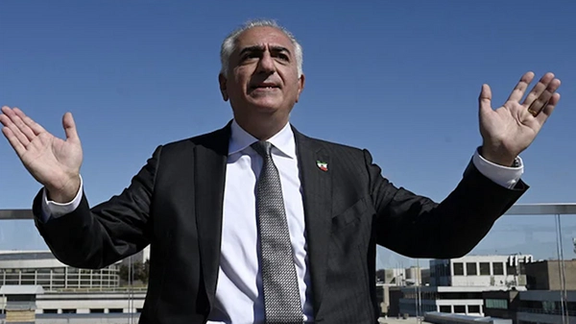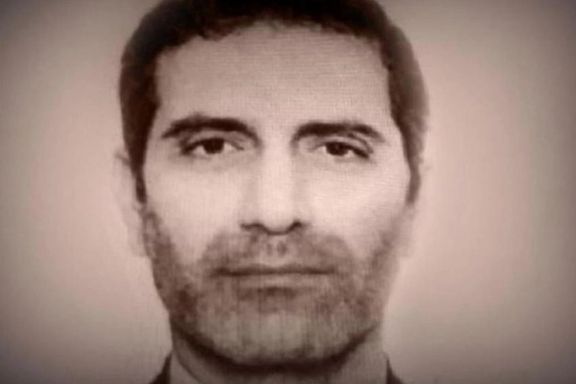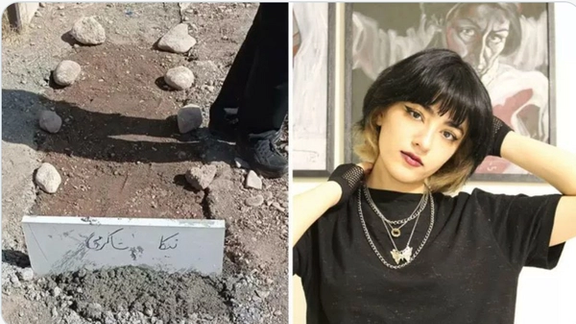Strikes, Protests Will Bring Iran’s Regime To Its Knees - Exiled Prince

Iran's exiled Prince Reza Pahlavi has hailed the protests and strikes by different social groups in the country, describing them as the right way to victory.

Iran's exiled Prince Reza Pahlavi has hailed the protests and strikes by different social groups in the country, describing them as the right way to victory.
In a tweet on Tuesday, the son of the late Shah of Iran said, “Multiple reports indicate the spread of strikes from cultural and educational sectors to the service and industry sectors,” calling it “a step in the right direction.”
“Nationwide strikes alongside nationwide protests will bring this regime to its knees,” Pahlavi added.
In an interview with Jerusalem Post on Monday, October 3, he described the current uprising in the country as the beginning of a revolution, saying, “We are indeed in more than tumultuous times in my country. We are in revolutionary times.”
“The popular uprisings we are seeing in hundreds of cities and towns across Iran have a very clear goal: the overthrow of the Islamic Republic and the establishment of a secular democracy based on human rights,” he said.
Earlier in the day, he also called US President Joe Biden not to enter an agreement with Tehran that would financially benefit the Islamic Republic’s repression machine.
As protests in Iran – sparked by the death of 22-year-old Mahsa Amini in police custody -- continue well into their third week, pundits and politicians speculate that Iranians are more angry than scared, and the government needs to be wise enough not step on mental mines, warning that suppression will make the protests more violent.

A court in Belgium has canceled the ban on the extradition of Iranian diplomat Asadollah Asadi, sentenced to 20 years in jail on a terrorism conviction.
Local Belgian media reported on Tuesday that a Brussels court ruled that Asadi may be extradited to Iran, thereby paving the way for a fiercely criticized prisoner exchange. The exchange would allow Asadi to be swapped with Belgian aid worker Olivier Vandeecasteele, who has been held in Iran since February, according to Het Nieuwsblad.
The temporary ban on the extradition of the convicted diplomat was announced by the Brussels Court of Appeal late in July following numerous complaints after the Belgian Parliament ratified a controversial prisoner swap treaty with Iran on July 20.
The Iranian exiled opposition group Mujahedin-e Khalq Organization (MEK) mounted a fierce campaign against the deal, challenging the possible extradition."The court has now declared the plaintiffs' question unfounded," said lawyer Khloë Georgiev, who represents Vandecasteele.
In June, Belgian MPs ratified a deal to allow the exchange. At the time, Prime Minister Alexander De Croo argued that it was the only way to get Vandeesteele back home safely. Recently appointed Foreign Minister Hadja Lahbib stresses that all diplomatic channels have been exhausted.
Assadi is imprisoned for “attempted murder and involvement in terrorism” for his role in plotting to bomb a gathering of the MEK near Paris in 2018.

Amid ongoing protests, many Iranians are mourning dozens of teens and young people, as names and details of the brutality against them emerge on social media.
Iran Human Rights, a Norway-based rights organization, said Tuesday that at least 154 protesters, including nine children have been killed by security forces during the recent protests. Very little is known about most of the victims as families are pressured to stay silent if they want the bodies of their loved ones to be handed over to them.
On Monday security forces stole the body of a teen victim, Nika Shakarami, from the morgue while her family were waiting at a cemetery in her late father’s hometown of Khorramabad for the body to arrive. They buried the young girl in a village about forty kilometers away, supposedly to prevent her funeral from turning into protests.
Thousands have shared photos and a video showing the 16-year-old Nika, shyly but playfully singing a song into a microphone. Nika was studying art in college and training to become a barista.
Nika was last heard from when she called a friend from the protests on September 20 saying she was being chased by security forces during a protest in Tehran against the killing of Mahsa Amini -- a 22-year-old girl killed in police custody earlier that week.
Nika’s body was found in a morgue at Kahrizak detention center ten days later. Authorities said she died “falling from a height” but refused to allow her mother and relatives see anything other than her face in the morgue. Her aunt said later that her nose and skull were smashed, apparently by multiple blows to her head.
Authorities later arrested Nika’s aunt and uncle after they publicized her death. Sources close to the family say the security forces are pressuring the family to say Nika had not been in the protests to reduce her killing to an unrelated murder case.
The Revolutionary Guards (IRGC)-linked Tasnim news agency published a report of the alleged murder of the young girl Tuesday blaming it on people outside the protests.
Tasnim claimed that Nika went to a commercial building kilometers away from the protests where her body was found, although her body was found at a detention center, and suggested that she may have been killed by workers who were resting in the building’s parking.
Eight of the workers have been arrested, Tasnim said, and the case has been referred to a prosecutor for investigation. Many expect the state broadcaster to show someone making a forced confess admitting to the young girl’s murder or blame it on people from among the protesters.
A video has been circulating on social media of the mother of 18-year-old Parsa Rezapour, sitting and wailing on a sidewalk in Karaj where her son was shot dead. “My child was killed for the sake of freedom … My child was martyred,” she cries.
In a video posted on social media the mother of 23-year-old Hadis Najafi, also shot dead in Karaj, has come forward saying she was shot in the heart, abdomen, and neck. “Her whole body and face showed shotgun wounds,” she says adding authorities hid her death from them and refused to hand her body over to them. Before leaving for the protest she posted a video of herself saying she was taking part because she wanted to remember these day years later “when everything will be different”.

The families of victims of Ukrainian flight PS752, shot down by Iran’s Revolutionary Guard in January 2020, held a demonstration in Canada, calling for tougher measures against Iran.
Chanting slogans against the Islamic Republic, the protesters gathered in front of the Canadian Parliament in Ottawa on Tuesday, the thousandth day since IRGC shot down the plane over Tehran and killed all passengers and crewmembers onboard.
The spokesperson of the association of victims’ families, Canada-based activist Hamed Esmaeilion, whose daughter and wife were killed in the tragic event, called for the expulsion of all the agents and officials affiliated with the Islamic Republic as well as their family members who have immigrated to Canada.
Criticizing the Canadian government, Esmaeilion said the regime's politicians, military and security personnel and their families have turned Canada into a "safe haven" for themselves and should be "deported without delay."
Prime Minister Justin Trudeau also issued a statement on the occasion, saying,“One thousand days ago today, the Iranian regime unlawfully and horrifically shot down passenger Flight PS752, cutting short the lives of the 176 innocent people on board,” adding, “Canada and its Coordination Group partners are committed to holding Iran accountable, in accordance with international law.”
In a joint statement for the occasion, the International Coordination and Response Group for the victims of Flight PS752, Canada, Sweden, Ukraine and the United Kingdom said, “We renew our demand that Iran fulfills its international legal obligations and ensures transparency and justice for its actions.”
The airliner was shot down by two air-defense missiles fired by the IRGC as it took off from Tehran’s Imam Khomeini International Airport, killing 63 Canadians.

As protests in Iran continue well into their third week, pundits and politicians speculate about why the current uprising has happened and where it is going.
Reformist commentator and political analyst Mohammad Reza Tajik has said in an interview with Didban Iran website that Iranians are more angry than scared, and the government needs to be wise enough not step on mental mines. He also warned that suppression will make the protests more violent.
On the other hand, the deputy leader of the reformist National Trust Party Esmail Gerami Moghaddam told Etemad Online website that the people's suppressed demands do not go away by suppression and re-emerge as events unfold. He warned that suppression will make the protests more violent.
Both Tajik and Gerami Moghaddam attached high significance to accumulated and suppressed popular aspirations and warn the government about unmet demands and forgotten promises.
Tajik said that protesters will inevitably return to the streets with an accumulated rage. The academic further said that the ongoing protests are different from what happened in previous years. He warned that the current generation of Iranians who have taken to the streets in recent weeks are part of a movement that has no ideology, no leader nor even an organization. He described the movement as "A unity within a plurality."
Schoolgirls chanting slogans for the dowfall of the Islamic Republic
The eye-catching presence of women in the uprising is another characteristic of this round of protests. It is a women's uprising, said Tajik, the former chief of the Iranian presidential office's Strategic Studies Center.
Quoting a prominent Iranian poet, Tajik said that the new generation of Iranians "does not like what it sees in society and cannot see what it likes."
He said the government wants the society to be timid and intimidated but the society is full of activists who do not wish to remain passive. Iranians are no longer obedient servants of the government, he said.
On the other hand, politician Gerami Moghaddam said that what we see today is a set of demands that were pushed back to the people's subconscious as a result of previous suppressions.
He reminded that the Iranian Constitution promised in its article 27 that protests are allowed in the Islamic Republic, and although everybody has been talking about this, the right to protest has never been recognized by successive governments during the past four decades. As a result, the people have lost their trust in the government and cannot believe its promises.
Gerami Moghaddam added that trust between the people and the government does not take shape easily, particularly if the government does not allow criticism and protest.
Although scholars and politicians have been debating the reasons of the current protests and although many of their arguments are valid, they are so intimidated by the regime's despotism that they never mention the root-cause of the problem which is the presence of a dictatorship that makes all the decisions without being accountable for their consequences. It is not responsive to people's views and ruthlessly crashes any resistance.
The fact that Supreme Leader Ali Khamenei finally spoke about the protests among military men rather than anywhere else, showed more or less that he feels safe only among the gunmen who protect him. In his speech, he blamed everyone and all foreign powers for the Iranian people's revolt, but it apparently never occurred to him that he and his decisions were responsible for the havoc that pushed him to his comfort zone at the corner of a military garrison to defend himself and attack others.
Previously, when he was more confident, he made such remarks at universities and among preachers at Friday prayers. It appears now, that he fears facing the people, even those who go to Friday Prayers.

Iran's foreign ministry summoned the British ambassador in Tehran on Tuesday in reaction to "interventionist comments" from the British foreign ministry.
"The British side, by issuing unilateral statements, shows that it has a role in the belligerent scenarios of terrorists active against the Islamic Republic," the director general of Western Europe at Iran's foreign ministry added, after saying that London's remarks on Iran's internal affairs were "based on fake and provocative interpretations."
Britain's foreign ministry said on Monday it had summoned the Iranian charge d’affaires, Iran’s most senior diplomat in Britain, over the crackdown on protests following the death of Mahsa Amini in custody.
"The violence levelled at protesters in Iran by the security forces is truly shocking," British Foreign Secretary James Cleverly had said.
The British envoy in Tehran was summoned on Tuesday, but local media reported it on Wednesday.
The Iranian official added Tehran consider possible options in response to any unusual actions from Britain.
A 22-year-old Kurdish Iranian woman, Amini was arrested on September 13 by the morality police in Tehran for wearing "unsuitable attire" and after two hours transferred to hospital with a serious injury to her head that put her into a coma. She died three days later, sparking nationwide protests. So far almost 150 people have been killed in the ensuing government crackdown.